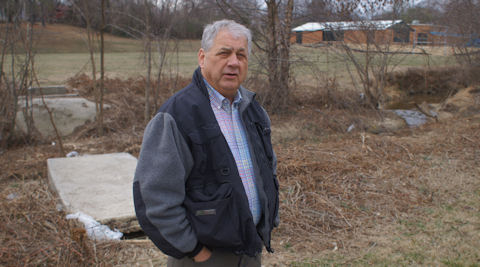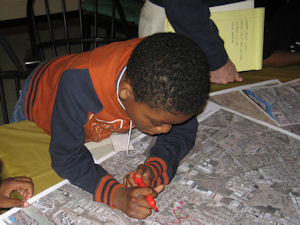About Bacon’s Rebellion
Bacon's Rebellion is Virginia's leading independent portal for news, opinions and analysis about state, regional and local public policy. Read more about us here.
Fixing Broken Streams and Broken Dreams

The Bellemeade Walkable Watershed project aims to reclaim a damaged creek, create a route for kids to walk to school, and boost community spirit in a gritty, inner-city Richmond neighborhood.
by James A. Bacon
Bob Argabright got involved with Richmond city schools nine years ago when he volunteered to help two young students learn to read. It wasn't long before he discovered that the challenges faced by inner city kids run far deeper than a difficulty with letters and words. As he delved deeper into their lives and their surroundings, his volunteer activity became a full-time vocation. Today, the retired paper industry executive is such a fixture at Oak Grove-Bellemeade Elementary School that children wave to him in the hall, call him by name and even run up to give him a hug.
"I think it's totally unfair for a child to be born in the 23229 zip code and be set for life while a child born in 23224 has a low probability of success," says Argabright. "Ninety percent of our kids say they want to be a rap star, an NFL football player or a beautician. We're trying to show them other paths. ... We're teaching these children to dream."
As unlikely as it might sound, Argabright is hoping that a few children might conceive the ambition of becoming an architect or an environmental engineer.
Making that connection would have been unlikely a year ago, when the students at Oak Grove-Bellemeade were attending the old Bellemeade Elementary School, an aged and decrepit school building that screamed urban blight. But this month they moved into a new, LEED-standard school building next door that is fresh, clean and airy. Every section of the school bears a name associated with the James River -- the river bed, forest floor, forest canopy, and the like -- to serve as inspiration for teaching about nature. Moreover, the city is moving forward with a project to restore the severely eroded creek behind the school with the aim of creating a community resource and a focus for environmental education.
The Bellemeade Walkable Watershed is a triumph of public-private collaboration, says Michelle Virts, deputy director of utilities. "It's a great opportunity for the city to stretch our dollars." The project is funded largely through a $187,000 National Fish & Wildlife grant to restore the creek, and a $60,000 Environmental Protection Agency grant to build a watershed coalition, but the city is chipping in land, public works money and staff time, while not-for-profits like the James River Association and the Alliance for the Chesapeake Bay are providing volunteers for clean-up and money for tree planting.
Perhaps the most intriguing aspect of the walkable watershed is how the community is leveraging a single project to advance multiple goals: stream restoration, environmental education, a community garden and a network of sidewalks and trails. By making it possible for hundreds of kids, many of whom live in housing projects, to walk or bicycle to school instead of ride the bus, the project, it is hoped, will ward off the obesity that plagues Richmond's inner city.
Many educators, public officials and not-for-profits have contributed to the project. But Argabright is the thread tying the efforts together. "Bob is extremely active in the neighborhood," says Virts. "He makes things happen."
"Bob Argabright is totally on fire about this thing," says Champe Burnley, president of the Virginia Bicycling Federation, who recalls meeting with him more than half a year ago. Argabright was thinking ahead to when the new route opens for children to walk and bike to school. How many poor kids own bicycles? Not many. Even back then, he was working the angles to rustle up some used bikes. He now has 300 (only some of which, he regrets, are suitable for children) sitting in a warehouse in anticipation of the day when they can be used.
Argabright is not one to claim credit. He sings the praises of everyone involved in the project, from Oak Grove-Bellemeade's principle Jannie Laursen to Lara Kling with the Blue Sky Fund, which has raised $275,000 to fund outdoor nature programs for inner city schools, including Oak Grove-Bellemeade. He depicts his contribution mainly as showing up at community events, pushing to get things done and building a web of contacts linking corporate leaders with City Hall and neighborhood volunteers and activists. Says he: "What I'm doing is networking, doing what I've done my whole career."
Re-greening Richmond
Two developments were key to making the project happen. One was construction of the Oak Grove-Bellemeade School, which opened its doors this year. Children from the old Bellemeade School, located right next door, moved in right away. Students from Oak Grove will transfer next school year. The 90,000-square-foot facility is state-of-the-art. But it's one thing to teach a subject like science in the abstract to inner-school children who have seldom ventured outside their concrete-and-asphalt domain, and quite another to teach them in a natural environment.
The other key was a study, conducted by the Charlottsville-based Green Infrastracture Center (GIS), to look at ways to "re-green" the city. The consultants took an inventory of the city's parks, greenways, parks, streams, fragments of green space, and vacant and under-utilized parcels.
"We decided that it would be helpful to provide a demonstration watershed for Richmond," says Karen Firehock, executive director. "Instead of doing small projects all over the city, we thought the city could be more effective by focusing on one watershed at a time, doing everything you possibly could do there, and doing a thorough job."
The Bellemeade area had a great need and a lot of potential, she says.The new, LEED-certified school was a great asset, but the park next door was an under-utilized eyesore. The creek running through the park was eroding, and an old foot-bridge had been washed away. GIS recommended using natural systems -- plants with deep, branching roots -- to stabilize the stream banks and a series of bioswales and rain gardens to reduce run-off into the stream. The plan also called for replanting trees, installing a community garden and repairing the creek bridges.
Instead of parachuting out-of-town consultants into the Bellemeade neighborhood to design all the details, the city obtained an Environmental Protection Agency grant to organize a watershed coalition. The grant provided resources to enlist members of the community, few of whom were civically active, to be "watershed restorers," in Firehock's words. The coalition enlisted the school, city agencies and not-for-profits, and hired a local community organizer to recruit local citizens.
Walking school buses
Besides restoring the stream, which is too small and forlorn to even have a name, the watershed initiative will make the park the last link in the neighborhood children's path to school.
The CIS study found that 80% of the kids attending Bellemeade lived within a 15-minute walk to school -- and they all rode the bus to school. The city spends between $60,000 and $80,000 a year busing kids to nearby Oak Grove Elementary, and that doesn't include the sum spent for Bellemeade, says Argabright. Building a walking-biking route to schools could pay for itself several times over just in the savings from busing costs.
Hillside Court, a 400-unit housing project in the Bellemeade neighborhood, is a zone of desolation for kids. The grounds are bare; there is nowhere to play. Mothers don't feel safe letting their children outside. Everyone except the bad guys retreats into their homes. Notice how every apartment has the shades pulled down to stop anyone from peering in, Argabright says, as he drives a visitor through the neighborhood. Fear, he says, is what keeps children cooped up and inactive indoors.
The easy part of restoring walkability to the Bellemeade neighborhood is installing park trails, renovating sidewalks and painting crosswalks at busy intersections. Convincing people to walk requires eliminating the fear factor. And that means engaging the whole neighborhood.
 The watershed coalition is adopting an idea pioneered in other communities -- the "walking bus." Teams of parents will escort the children from the projects to the school. Block captains will be recruited along the route to sit on their front porches in the morning and cheer the kids on their way. Contributing ideas on how they would like to walk to school, a group of 5th graders drew maps of their preferred routes and suggested creating events like a race-to-school day with prizes for the fastest kids. They even suggested giving a name to the creek. "They wanted to create an identify for it," says Firehock.
The watershed coalition is adopting an idea pioneered in other communities -- the "walking bus." Teams of parents will escort the children from the projects to the school. Block captains will be recruited along the route to sit on their front porches in the morning and cheer the kids on their way. Contributing ideas on how they would like to walk to school, a group of 5th graders drew maps of their preferred routes and suggested creating events like a race-to-school day with prizes for the fastest kids. They even suggested giving a name to the creek. "They wanted to create an identify for it," says Firehock.
Hopefully, creating the walkable watershed is just the beginning of what the neighborhood can accomplish. Argabright is encouraging Bellemeade residents to think big. The project includes a community garden where residents will grow their own fruits and vegetables. Argabright dreams of starting up a program to teach the value of fresh, healthy food -- and how to cook it. He is working also on raising funds to add lights to a soccer field and create a soccer program. African-Americans in Bellemeade have no tradition of playing soccer but the increasing number of Hispanics in South Richmond do, he says. A soccer program with a dozen teams, he adds, will build community spirit and involve fathers in the lives of their children.
"The community sees outside groups come and go," says Argabright. "They get a little cynical." Perhaps the most lasting legacy of the watershed project is the opportunity to help the people of Bellemeade build the organizational skills and aptitudes they need to understake projects on their own.
That could be the most enduring legacy of all.
=============================================
This article was made possible by a sponsorship of Bon Secours of Virginia Health System.

